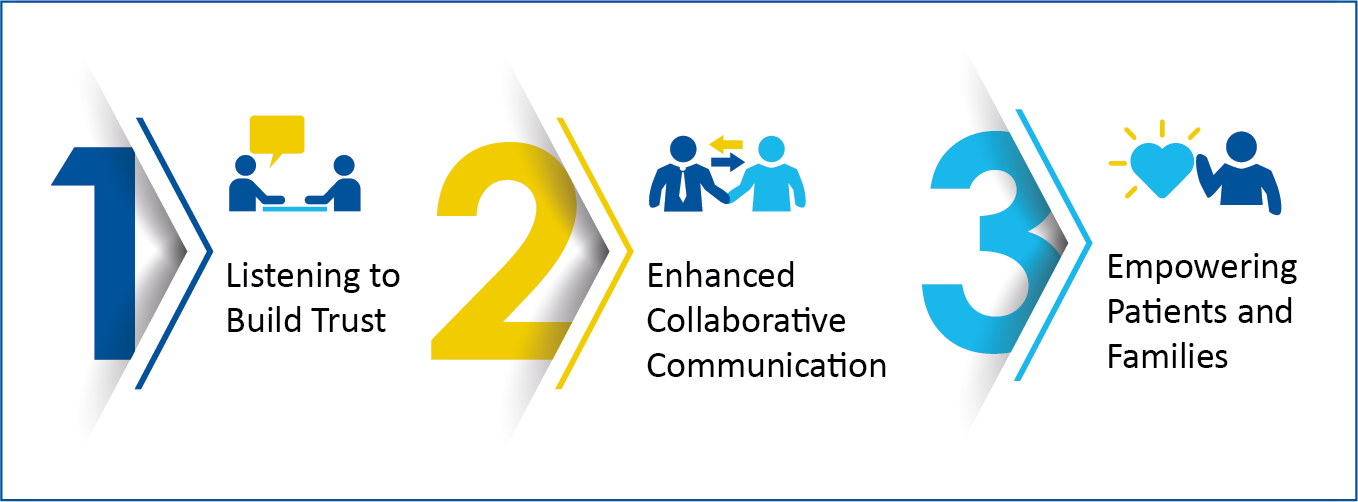Engaging patients and families is crucial for improving care quality because it ensures that care is more personalized and aligned with the patient's needs and preferences. When patients and families are actively involved, especially at the beginning of an initiative, they can provide valuable insights that help tailor treatment plans, clarify medical advice, and enhance communication. This collaboration often leads to better health outcomes, increased satisfaction with care, and more efficient use of resources, as patients are more likely to be proactive in managing their health and seeking timely medical attention. The following examples demonstrate the impact of patient and family engagement across care settings.
West Virginia Nursing Home Enhances Infection Prevention through Family Engagement
A 130-bed nursing home in West Virginia is demonstrating how patient and family engagement can lead to significant improvements in care quality. The facility established a Family Involvement Committee, engaged members in the nursing home’s infection prevention efforts and achieved the following outcomes:
- Enhanced Infection Prevention Procedures: The Family Involvement Committee played a crucial role in reinforcing personal protective equipment (PPE) usage among the facility staff. Their involvement ensured that protocols were not only implemented but also maintained through positive reinforcement for the staff.
- Transparency and Trust: Transparency was key to building trust within the facility and with the resident’s families. Using audits and an “open mic” approach to gathering feedback from families, the nursing home fostered a culture of openness and accountability.
- Effective Communication: The facility emphasizes clear and consistent communication through weekly calls, text alerts, and direct access to leadership. These methods ensure that all stakeholders are informed and involved in infection prevention efforts at the nursing home.
- Collaboration for Quality Care: Collaboration between families, residents, and staff is central to the facility’s continued success. The Family Involvement Committee’s feedback is instrumental in understanding residents' needs and enhancing training programs ensuring the staff’s ability to provide more dignified quality care.
Providence Mission Hospital Reduces Disparities in Sepsis Care for LEP Patients
Providence Mission Hospital’s goal to address health inequities and health disparities highlights the transformative potential of patient and family engagement. In 2023, the hospital sought to identify and address the factors contributing to increased Average Lengths of Stay (ALOS) and Readmissions among sepsis patients with Limited English Proficiency (LEP). Key elements of this initiative include:
- Focus group input: Prior to conceptualizing the appropriate intervention, Providence Mission Hospital structured focus groups to identify opportunities to improve care for Sepsis LEP patients, including understanding the disease process, building trust, and enhancing communication with the care team. By listening and incorporating feedback from the beginning, it ensured the opportunities for improvement were being addressed appropriately.
- Patient-centric support: The program reallocated existing resources to create culturally competent and linguistically appropriate care through a Sepsis Nurse Navigator role. These navigators provide personalized support, build trust, and improve communication between the patient and the care team.
Between September 2023 and June 2024, Providence Mission Hospital reduced ALOS for sepsis patients with limited English proficiency by 25 percent and readmissions for sepsis LEP patients by 28 percent. The project’s success underscores the importance of engaging patients in their care.
Key Strategies for Effective Patient and Family Engagement

1. Listening to Build Trust
Focus groups and listening sessions offer powerful insights into the needs and concerns of patients and families. These sessions provide a safe space for participants to share their experiences, particularly when conducted in their preferred language and with cultural sensitivity. For example, conducting focus groups in Spanish moderated by fluent speakers can eliminate language barriers and foster trust. This approach allows healthcare providers to capture genuine insights, which are critical for designing care strategies that are responsive to the community’s needs.
2. Enhanced Collaborative Communication
Communication is key to building trust and improving outcomes. In addition to providing interpreters and translated material, effective communication requires a deep understanding of cultural nuances. Utilizing trusted community members or culturally competent navigators can bridge gaps in understanding, ensuring that patients and families are fully engaged in their care. This strategy is particularly effective in communities with a high prevalence of Limited English proficiency (LEP) individuals, where misunderstandings can lead to significant barriers in accessing quality care. Establishing a variety of communication methods with a regular delivery cadence ensures patients and families continually have opportunities to be heard.
3. Empowering Patients and Families
Empowering patients and families through active involvement in decision-making processes leads to improved outcomes. This empowerment can be facilitated by providing accessible and relevant education, ensuring patients understand their conditions, treatment options, and the importance of follow-up care. By fostering a sense of ownership in the care process, healthcare providers and facilities can cultivate more meaningful partnerships with patients and their families.
The Path Forward
Engaging patients, families, and community partners is not just a strategy, it’s a necessity for achieving patient care quality improvement goals. By optimizing communication, incorporating culturally sensitive practices, and involving patients and families in the decision-making process, healthcare providers can better identify challenges and co-create solutions that lead to sustainable, equitable care. The experiences of the West Virginia nursing home and Providence Mission Hospital serve as powerful examples of how effective engagement can drive positive change in healthcare. Embracing a patient-centered approach that values the voices of those served are key to building a future where healthcare is truly inclusive, equitable, and patient-centered.
This material was prepared by The Bizzell Group (Bizzell), the Data Validation and Administrative (DVA) contractor, under contract with the Centers for Medicare & Medicaid Services (CMS), an agency of the U.S. Department of Health and Human Services (HHS). Views expressed in this material do not necessarily reflect the official views or policy of CMS or HHS, and any reference to a specific product or entity herein does not constitute endorsement of that product or entity by CMS or HHS. 12SOW/Bizzell/DVA-1451-09/16/2024.

